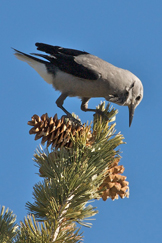Benkman Lab at the University of Wyoming
I'm an evolutionary ecologist whose recent research has focused on mostly four questions. 1) How do interactions between crossbills (Loxia) and conifers influence crossbill diversification, and what influences the form, consistency, and strength of these and other plant-animal interactions? 2) How and why does reproductive isolation evolve between diverging lineages of crossbills? 3) Why has the South Hills crossbill (now Cassia crossbill Loxia sinesciuris) declined by 80% between 2003 and 2011, and what can be done to minimize future declines? Such a dramatic decline, apparently due to increasing temperatures that reduce seed availability in subsequent years, is especially alarming as this species is confined to two small mountain ranges in southern Idaho. 4) Why and how do certain interactions between mammals and plants lead to trait-mediated indirect interactions that cascade to other community members and ecosystem processes?
The great naturalist and myrmecologist from Cornell University, Dr. William L. Brown, Jr. (1922-1997), wrote in The Quarterly Review of Biology in 1957 "Were I an ornithologist, I think that the finches of the genus Loxia would take up most of my research time. No group of birds seems to offer more tantalizing problems in that area of biology where systematics, ecology, zoogeography, population dynamics, and ethology overlap." I agree.
For Everyone:
For information about finding the Cassia Crossbill see this page on Idaho Birds.
Nick Neely, the author of the article (July 2017) in High Country News about the natural history and conservation concerns for the Cassia Crossbill, received a 2017 AAAS Kavli Science Journalism Award for his article. Here's a podcast about this work by Laura Erickson.
The South Hills (Cassia) Crossbill is evolving in a seriously bizarre way, an article in Wired magazine on our 2016 paper in Molecular Ecology.
A Small Mammal With Outsized Impact, a post of our blog on our 2014 publication in PNAS.
For Teachers:
CourseSource for a coevolution lesson plan based on the coevolutionary interactions between crossbills, squirrels, and lodgepole pine.

